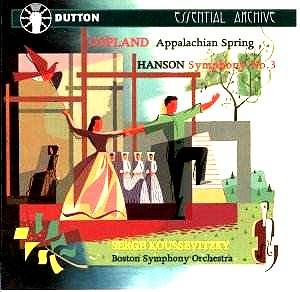 Composer: Aaron Copland
Composer: Aaron Copland
Works: Appalachian Spring Suite (1944), Lincoln Portrait (1942), Howard Hanson Symphony No. 3 (1938)
Performers: Boston Symphony Orchestra, Serge Koussevitzky (conductor), Melvyn Douglas (narrator)
Recording: Symphony Hall, Boston: 31 Oct 1945 (Appalachian), 20 Mar 1940 (Hanson), 2 Feb 1946 (Lincoln) mono ADD
Label: Dutton Laboratories Essential Archive CDEA5021
Aaron Copland’s music, with its unmistakable American idiom, often serves as a lens through which to view the nation’s evolving cultural landscape, particularly in times of strife. The works presented here—Appalachian Spring Suite, Lincoln Portrait, and Howard Hanson’s Symphony No. 3—are emblematic of the wartime spirit and reflect the optimism and introspection that characterized the era. Copland’s Appalachian Spring, originally a ballet commissioned by Martha Graham, stands out for its lyrical beauty and innovative use of folk themes, capturing the essence of rural America just as the nation was engulfed in the turmoil of World War II.
The performance under Serge Koussevitzky is notable for its vibrant orchestration and palpable emotional gravitas. Koussevitzky’s interpretation of Appalachian Spring is particularly engaging; the conductor’s ability to navigate the delicate balance between the work’s buoyant energy and its more introspective passages is commendable. The orchestral colors bloom vividly, particularly in the expansive opening, where the “deliciously rushed slides” of the strings coalesce with the “deep-running bass-heavy figures.” This interplay between the exuberant and the contemplative is realized with a deftness that recalls the influence of Stravinsky, evident in the rhythmic vitality that permeates the score. Koussevitzky’s approach to the final section is especially striking, where he imbues the conclusion with a symphonic weight that elevates the work beyond its ballet origins, transforming it into a powerful statement of farewell.
Hanson’s Symphony No. 3 provides an interesting juxtaposition, characterized by its lush Romanticism and expansive themes. The initial movements are replete with the “Pohjolan and Brucknerian rumblings” that echo through the orchestral texture, creating a sense of grandeur and depth. However, one finds the finale lacks the momentum present in earlier sections, where the pesante passages sometimes detract from the overall flow. The andante tranquillo, while aiming for breadth, falls short of its potential, hinting at grandeur yet ultimately feeling constrained. Still, Koussevitzky’s pacing allows for moments of sinister beauty, particularly in the finale where the orchestration echoes the surrealism of Hanson’s opera, Merry Mount.
The Lincoln Portrait, narrated by Melvyn Douglas, captures the stirring essence of the text while also allowing the music to resonate with its own narrative. The poignant phrase “He was born in Kentucky” stands as a highlight, revealing the tender undercurrents of Copland’s score. While some may argue that other recordings, such as those featuring James Earl Jones or Charlton Heston, offer superior interpretations, Douglas’s delivery here is imbued with a sincere gravitas that complements the music effectively. The orchestral accompaniment manages to support the narrative without overwhelming it, maintaining clarity throughout.
Sound quality, while mono and reflective of its time, does not significantly impede the listening experience. The engineering, characteristic of Dutton Laboratories’ Essential Archive series, allows for a satisfactory presentation of these historic performances. The warmth of the orchestral sound and the clarity of the solo lines come through well, making the recording a valuable addition to anyone’s collection of American orchestral music.
This collection of works not only serves as an important historical document but also as a testament to the enduring qualities of American music during a time of uncertainty. Each piece offers a distinct perspective on the era, with Koussevitzky’s interpretations bringing a sense of urgency and depth that resonates even today. The compelling performances, combined with the rich emotional landscapes of Copland and Hanson, make this recording a significant contribution to the understanding of American classical music in the 20th century.



